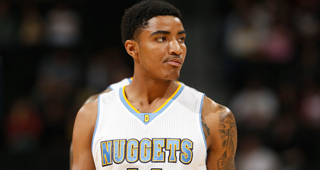Extensions of Rookie Scale Contracts are primarily detailed in Article VII, Section 7(b) of the 2017 Collective Bargaining Agreement.
Who is eligible for a rookie scale extension?
Players selected in the first round of the NBA Draft are subject to the league’s rookie scale unless they still have not signed three years after their draft and both the player and the team that holds their rights agree to a non-rookie scale contract, like Nikola Mirotic in Chicago and Bogdan Bogdanovic in Sacramento.
Rookie scale contracts have fully guaranteed first and second seasons at values dictated by the rookie scale included in the CBA, then third and fourth year team options that must be exercised or declined by the start of the preceding season (i.e. teams are deciding on rookie scale players’ 2018-19 options before Opening Night 2017).
As such, a player who has both his third and fourth year team options picked up may agree to a rookie scale extension.
What are the parameters of rookie scale extensions?
There are two varieties of rookie scale extensions: Designated Rookie and everything else. Designated Rookie extensions have been broken down elsewhere in the CBA Encyclopedia but the basic terms are that the agreement adds five new seasons starting no lower than the player’s 25% max salary and potentially higher depending on the terms of their specific agreement if the player qualifies for the “5th Year 30% Max Criteria” commonly known as the Rose Rule. It also must include maximum 8% raises.
Rookie scale extensions outside of the Designated Rookie framework are more straightforward. They can add anywhere from one to four years to the contract at any value from the player’s minimum to their 25% maximum with up to 8% raises or decreases for any given season (calculated off the first year salary).
Why are rookie scale extensions different than other extensions?
It makes sense for the league to have different rules for rookie scale extensions because those players have an identical set of circumstances that are somewhat different from players who join the league other ways, most notably their contracts having multiple team options and typically serving as below market since the rookie scale artificially lowers young players’ salaries.
When can a player and team sign a rookie scale extension?
According to Article VII, Section 7(b)(1) of the CBA, an extension of a rookie scale contract can only happen from 12:01pm Eastern on the last day of the July Moratorium to 6 p.m. Eastern on the day before the first day of the regular season of the second option year (fourth and final season) of the player’s rookie scale contract.
What if the player is traded during the first three years of his rookie scale contract?
Players who have both options picked up are eligible for a rookie scale extension even if they are traded during the extension window. A prominent example of this is James Harden, who agreed to a deal with Houston four days after Oklahoma City traded him back in 2012. This is different from the restrictions the CBA puts on in other circumstances, typically called an “extend-and-trade.”
Who has signed a rookie scale extension this off-season?
Joel Embiid (five years, $148 million with Philadelphia)
Gary Harris (four years, $84 million with Denver)
TJ Warren (four years, $50 million with Phoenix)
Who is still eligible for rookie scale extensions this off-season?
Andrew Wiggins, Jabari Parker, Aaron Gordon, Dante Exum, Marcus Smart, Julius Randle, Nik Stauskas, Noah Vonleh, Elfrid Payton, Doug McDermott, Zach LaVine, Jusuf Nurkic, Bruno Caboclo, Rodney Hood, Shabazz Napier, Clint Capela and Kyle Anderson.
Will the rookie scale extension system change in the future?
Probably not, outside of tweaks to the Designated Rookie system which is somewhat distinct from the other rookie scale extensions. How teams and players approach rookie scale extensions has and will continue to shift depending on circumstances, with recent reductions in available cap space affecting players’ willingness to get deals done.



